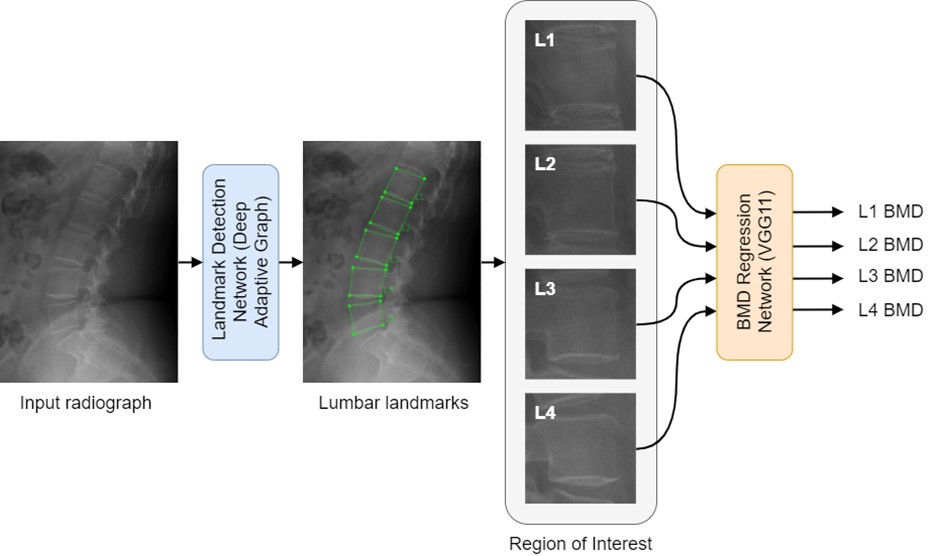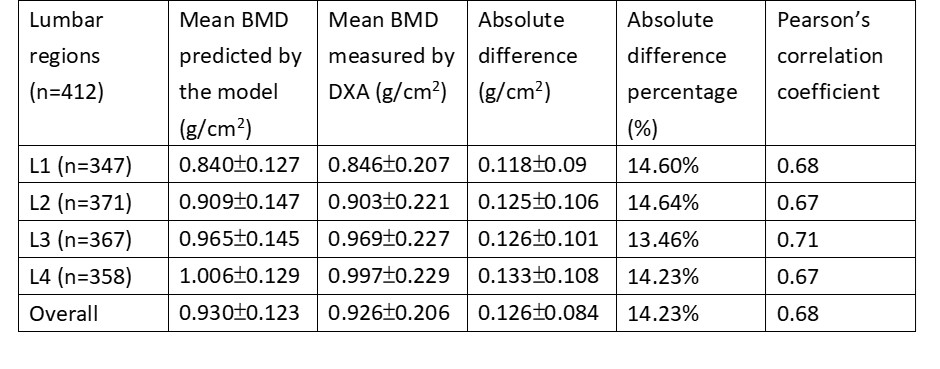Session Information
Session Type: Abstract Session
Session Time: 3:00PM-3:50PM
Background/Purpose: Osteoporosis is a silent disease characterized by a decrease in bone mineral density (BMD), causing bone fragility and increased risk of fracture. The most widely used screening tool for osteoporosis involves the use of dual-energy x-ray absorptiometry (DXA) to measure BMD. Vertebral plain films may serve as an opportunistic screening for osteoporosis to improve screening rates at no additional cost or radiation to patients. We describe a novel approach to assess vertebral BMD using plain film with deep learning and compare the performance with the DXA measurement.
Methods: In this study, we identified 2171 patients who underwent DXA and lateral plain film of lumbar vertebrae within six months. The dataset was split into a training set with 1796 patients and a testing set with 412 patients. First to fourth lumbar vertebrae images were detected automatically by using the Deep Adaptive Graph (a landmark detection technique based on graph convolutional network) and regions of interest (ROI) in each lumbar vertebra were segmented. The ROIs are processed using a regression neural network with a VGG11 backbone that was applied to each ROI to predict the BMD (Figure 1). During training, five-fold cross-validation is performed with an 8:2 split ratio of training/validation sets. The five models obtained from the cross-validation are all used to predict BMD on the input image of the testing set, and the predictions are averaged to produce the final output. Images with vertebral fractures were excluded from the analysis. Pearson’s correlation coefficient was used to assess the correlation between predicted and reference BMD.
Results: We included 395 women and 71 men in the testing dataset (female, 84.8%; mean age, 69.5 ± 10.7 years). The mean predicted BMD of first to fourth lumbar vertebrae was 0.930 g/cm2 compared with that measured by DXA of 0.929 g/cm2 (Student’s t-test, p = 0.65). The mean absolute difference was 0.126±0.084 g/cm2, with an absolute percentage difference of 14.6%. Pearson’s correlation coefficient between predicted and true BMD was 0.68. The performance of the model to predict BMD and Pearson’s correlation coefficient between predicted and measured BMD for each lumbar vertebra were shown in Table 1.
Conclusion: This study demonstrated that the deep learning model could predict vertebral BMD with reasonable precision, which might support automatic opportunistic bone density screening.
 Figure 1. Schematic representation of deep learning models to extract image features for estimation of lumbar vertebral BMD.
Figure 1. Schematic representation of deep learning models to extract image features for estimation of lumbar vertebral BMD.
 Table 1. Performance of prediction model for BMD using plain film compared with the measured BMD
Table 1. Performance of prediction model for BMD using plain film compared with the measured BMD
To cite this abstract in AMA style:
Hsieh C, Kuo C, Miao S, Zheng K, Lu L. Predicting Bone Mineral Density of Lumbar Vertebrae by Assessing Plain Film with Deep Learning [abstract]. Arthritis Rheumatol. 2020; 72 (suppl 10). https://acrabstracts.org/abstract/predicting-bone-mineral-density-of-lumbar-vertebrae-by-assessing-plain-film-with-deep-learning/. Accessed .« Back to ACR Convergence 2020
ACR Meeting Abstracts - https://acrabstracts.org/abstract/predicting-bone-mineral-density-of-lumbar-vertebrae-by-assessing-plain-film-with-deep-learning/
